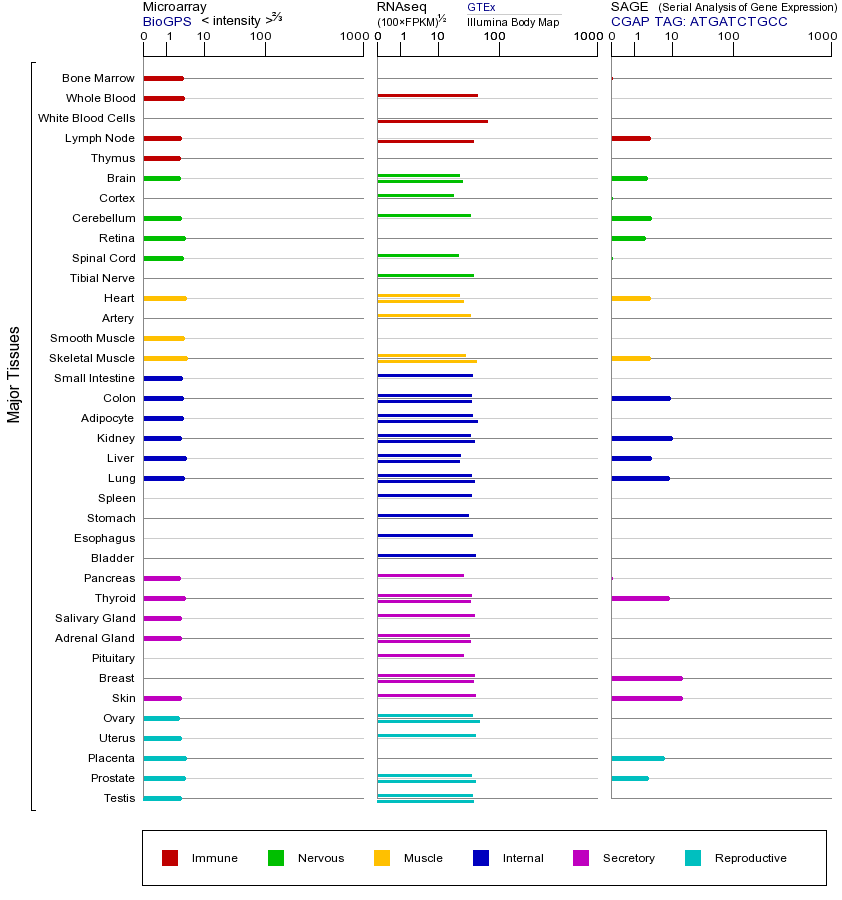SP1 (Sp1 transcription factor)
- symbol:
- SP1
- locus group:
- protein-coding gene
- location:
- 12q13.13
- gene_family:
- Zinc fingers, C2H2-type|Sp transcription factors
- alias symbol:
- None
- alias name:
- specificity protein 1
- entrez id:
- 6667
- ensembl gene id:
- ENSG00000185591
- ucsc gene id:
- uc001scw.4
- refseq accession:
- NM_001251825
- hgnc_id:
- HGNC:11205
- approved reserved:
- 1991-06-04
SP1(Specificity Protein 1)是一种重要的转录因子,属于SP/KLF(Krüppel-like factor)基因家族。该家族成员均含有锌指结构域(一种能结合DNA的蛋白质模块),主要通过与GC-rich(富含GC碱基)的DNA序列结合来调控基因表达。SP1广泛参与细胞增殖、分化、凋亡、代谢及免疫应答等过程,其作用位点集中在靶基因的启动子或增强子区域(调控基因表达的DNA片段)。SP1通过激活或抑制下游基因(如细胞周期蛋白、生长因子、癌基因等)影响多种生理功能。突变可能导致SP1失去DNA结合能力或稳定性,引发异常基因表达,与癌症(如乳腺癌、胃癌)、神经退行性疾病(如阿尔茨海默病)及糖尿病相关。SP1过表达常见于肿瘤,通过促进细胞周期进展和抑制凋亡加速肿瘤发展;同时可能抑制其他转录因子(如p53)的功能。其低表达则可能导致发育缺陷或代谢紊乱。SP/KLF家族的共性是依赖锌指结构识别特定DNA序列,但不同成员调控的靶基因和生物学功能存在差异,例如KLF4参与干细胞多能性维持,而SP1更侧重基础细胞活动的调控。SP1还受翻译后修饰(如磷酸化、糖基化)调控,这些修饰可改变其活性或稳定性,进一步影响其功能网络。
The protein encoded by this gene is a zinc finger transcription factor that binds to GC-rich motifs of many promoters. The encoded protein is involved in many cellular processes, including cell differentiation, cell growth, apoptosis, immune responses, response to DNA damage, and chromatin remodeling. Post-translational modifications such as phosphorylation, acetylation, glycosylation, and proteolytic processing significantly affect the activity of this protein, which can be an activator or a repressor. Three transcript variants encoding different isoforms have been found for this gene. [provided by RefSeq, Nov 2014]
由该基因编码的蛋白质是结合许多启动子的富含GC的基序一个锌指转录因子。所编码的蛋白质是参与许多细胞过程,包括细胞分化,细胞生长,细胞凋亡,免疫反应,DNA损伤反应,和染色质重塑。翻译后修饰如磷酸化,乙酰化,糖基化,和蛋白水解加工显著影响该蛋白,它可以是一个活化剂或阻抑物的活性。已发现该基因编码不同亚型三个抄本变形。 [由RefSeq的,2014年11月提供]
基因本体信息
SP1基因(以及对应的蛋白质)的细胞分布位置:
- 质膜
- 细胞质
- 细胞外
- 高尔基体
- 囊泡
- 细胞骨架
- 内质网
- 细胞核
- 内体
- 溶酶体
- 线粒体
SP1基因的本体(GO)信息:
| 名称 |
|---|
| 4350 TGF-beta signaling pathway [PATH:hsa04350] |
| 4915 Estrogen signaling pathway [PATH:hsa04915] |
| 5231 Choline metabolism in cancer [PATH:hsa05231] |
| 5202 Transcriptional misregulation in cancers [PATH:hsa05202] |
| 5016 Huntington's disease [PATH:hsa05016] |
| 名称 |
|---|
| Activation of gene expression by SREBF (SREBP) |
| Cellular responses to stress |
| Cellular Senescence |
| Fatty acid, triacylglycerol, and ketone body metabolism |
| Gene Expression |
| Generic Transcription Pathway |
| Metabolism of lipids and lipoproteins |
| Oncogene Induced Senescence |
| PPARA activates gene expression |
| Regulation of cholesterol biosynthesis by SREBP (SREBF) |
| Regulation of lipid metabolism by Peroxisome proliferator-activated receptor alpha (PPARalpha) |
| Signaling by TGF-beta Receptor Complex |
| SMAD2/SMAD3:SMAD4 heterotrimer regulates transcription |
| Transcriptional activity of SMAD2/SMAD3:SMAD4 heterotrimer |
| 疾病名称 | 关系值 | NofPmids | NofSnps | 来源 |
| Neoplasm Metastasis | 0.121628651 | 7 | 0 | BeFree_CTD_human |
| Neoplasm Invasiveness | 0.12 | 1 | 0 | CTD_human |
| Neoplastic Cell Transformation | 0.12 | 1 | 0 | CTD_human |
| Hyperglycemia | 0.12 | 1 | 0 | CTD_human |
| Skin Neoplasms | 0.12 | 1 | 0 | CTD_human |
| Anoxia | 0.013621751 | 5 | 0 | LHGDN |
| ovarian neoplasm | 0.0054487 | 2 | 0 | LHGDN |
| Colonic Neoplasms | 0.0054487 | 2 | 0 | LHGDN |
| Mammary Neoplasms | 0.0054487 | 2 | 0 | LHGDN |
| Stomach Neoplasms | 0.0054487 | 2 | 0 | LHGDN |
联系方式
山东省济南市章丘区文博路2号 齐鲁师范学院 genelibs生信实验室
山东省济南市高新区舜华路750号大学科技园北区F座4单元2楼
电话: 0531-88819269
E-mail: product@genelibs.com
微信公众号
关注微信订阅号,实时查看信息,关注医学生物学动态。







